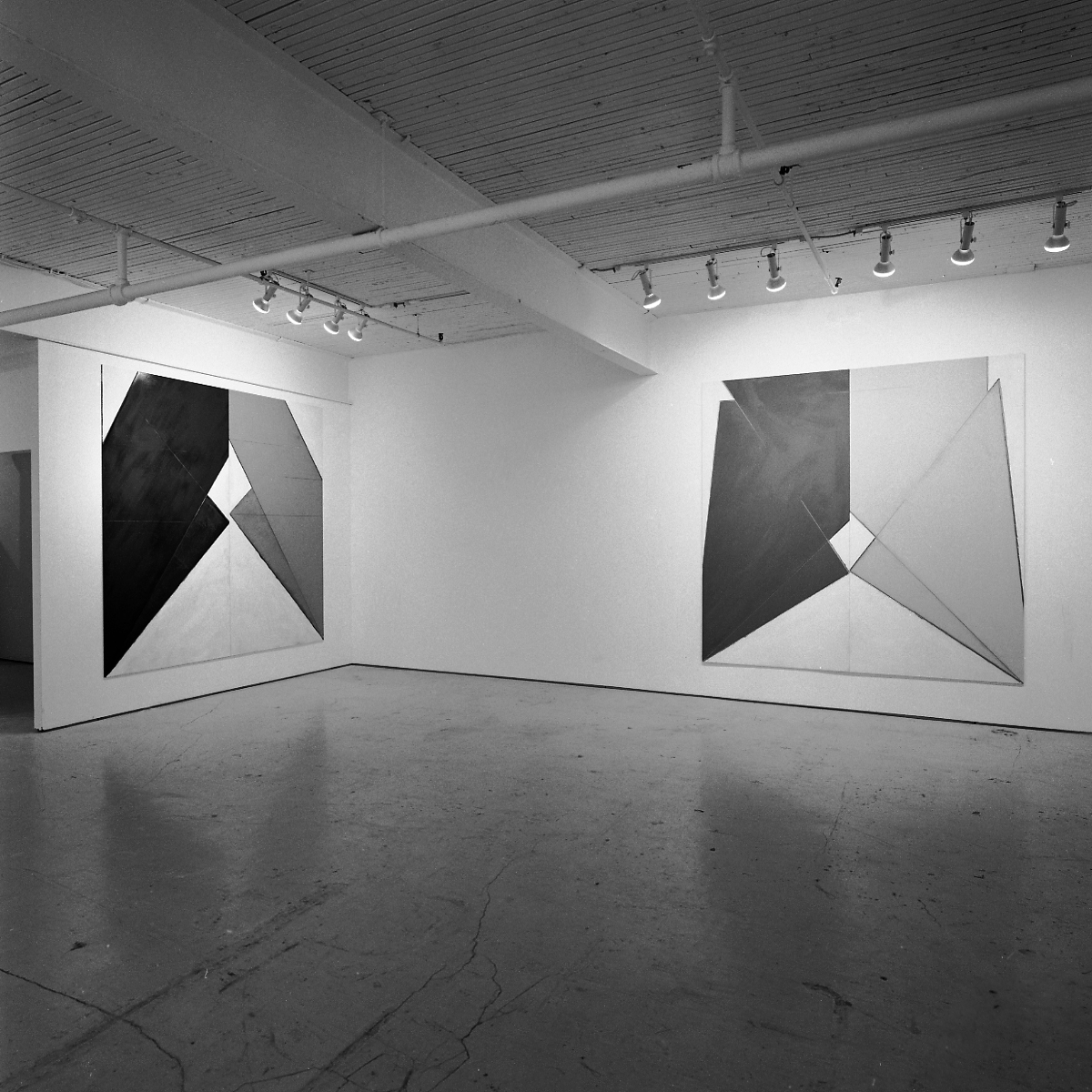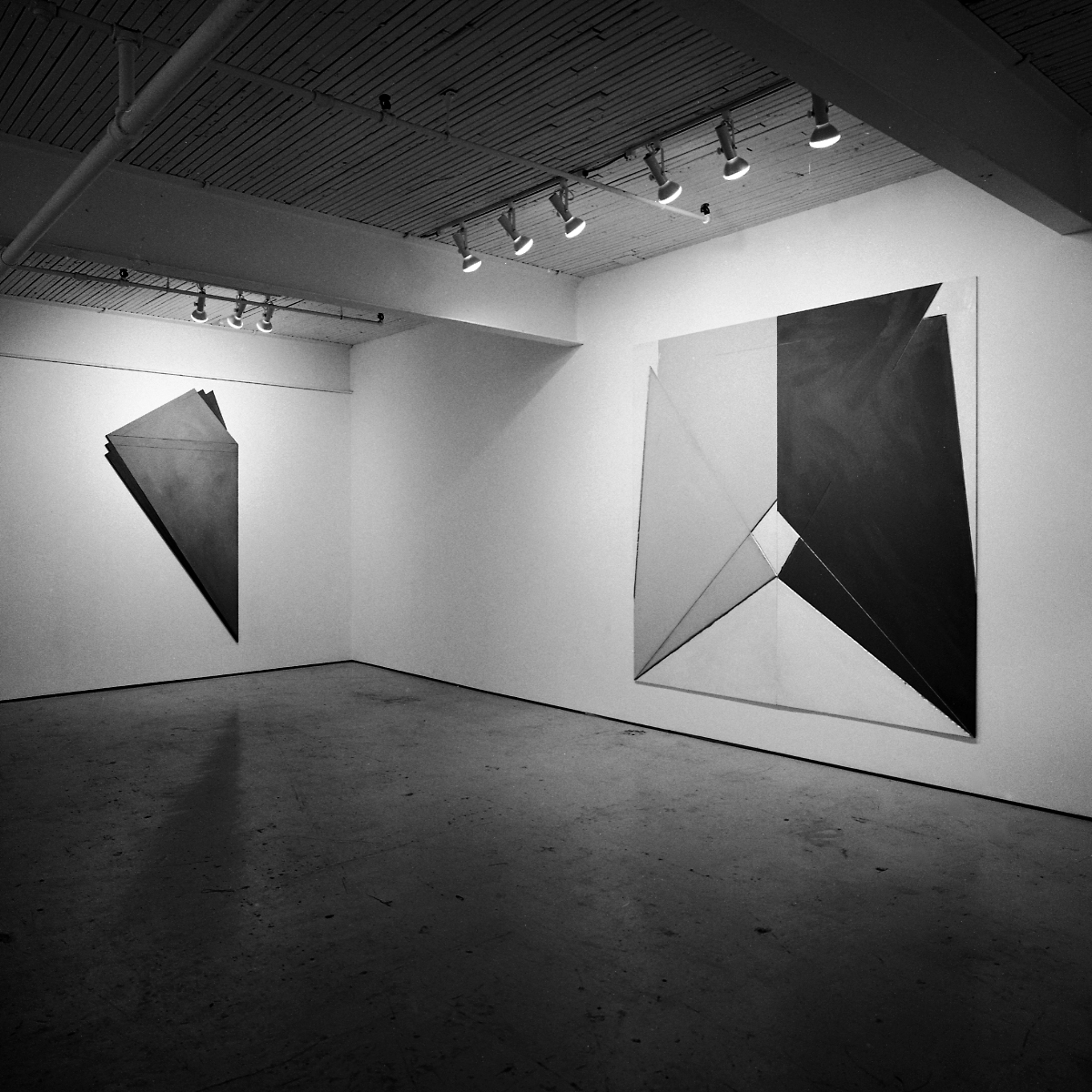West Gallery:
Ric Evans' exhibition includes five oil on wood (four of which measure 8' x 8') and four oil sketches.
The work continues an exploration of a measured concern in non-objective paintings.
Ric Evans
Mercer Union
Toronto
(An interview with Ric Evans by Robert Bowers: Bowers is "R" and Evans is "Ric''.)
R: What is the theory behind your work? Work that has this appearance usually emerges from a theoretical proposition.
Ric: Well, there's a lot of formalism in my work. Attention to design. I'm a 20th century history buff. I'm naturally inclined to dive into that area of design: shape, colour, strong presentation. R: Colour seems to be prominent in the new works at Mercer Union. Ric: Yes. In all but one painting it's intuitive. The red, black and white one is purposefully Supremacist. That's historical colour in my view.
R: In my asking about theory, it's that painting which prompts me to think about Malevich and the constructivist propositions about painting.
Ric: Well, a new order, a new way of looking at things. The presentation is a big thing for me: the physical properties of the work. Historically those guys weren't that much interested in such things. They would stretch the canvas and paint. My salle is much larger than theirs. You see, I went to school in the Sixties: The Greenberg School (Frank Stella) and Ron Davis and England's Richart Smith. That's what flavours my work. I can't get rid of it. It's part of the rhythm.
R: Do you want to get rid of it?
Ric: No, I'm growing out of it. But theory, just talking straight theory.... In making the painting I'm dealing with a geometric shape and then reversing it, like opening a book. R: So that's the procedure. Why the rectangle and consistently straight lines?
Ric: There's no reason why. That's kind of a funny question. Why is this a chair and not a table?
R: Well, it's a chair because we use it as a chair. But a painting is a proposition, or at least a set of choices.
Ric: Using straight lines is one way of making a painting; a chosen restriction. I like seeing things in their own area. A straight line is stronger than a curved one. There seems to be some thing about order in a straight line. OK so that's why straight line. It increases orderliness. It gives the painting my sense of order.
R: But it's hard--especially braving seen your works over a number of years--not to connect them with the Constructivists. So what has happened to the constructivist ideology?
Ric: I'm so removed from its roots that I am looking at it from a purely aesthetic point of view. I'm doing these paintings for my own aesthetic pleasure. I'm totally apolitical with respect to the painting. This is 1982 after all. I don't see it as breaking ground per se. I have the historical advantage of being born forty years after the fact.
R: The one thing that the work has in common with these roots is the notion of the self-referential object.
Ric: I consider them very non-objective. The Suprematists were mystics. I'm connected to the Sixties: art for art's sake. I see my painting as it is. The phenomena of looking at it is just seeing colour and shape, of drawing you in to look at a surface. And that in itself is, I think, a very large statement in painting.
R: How is identity involved?
R: It has to be a part of you. I'm reaching a point of almost elegance. Instead of paring away I'm adding. I can see it getting almost baroque.
R: But to me it seems very monastic. Slow change. There's a caution about making changes.
Ric: I delight in plotting. John Mays called the work "plotting", I think as a put-down, but I take it as a very positive statement. Order. I like to see one thing leading into the next. I'm always skeptical of people that change quickly no matter how sincere they are. The paintings in the gallery are a result of that kind of attitude. So they are more about my attitude and my way of working than the actual product. They are measured and enjoy that device.
R: It is interesting that historically arithmetic was a link to pure form. Ric: Malevich never painted a true square in his whole life.
R: It was the idea of a square.
Ric: I measure things out. The propositions arise out of the consistency of my personality. Perhaps I should just feel. I think I've come to measure as a matter of habit.


